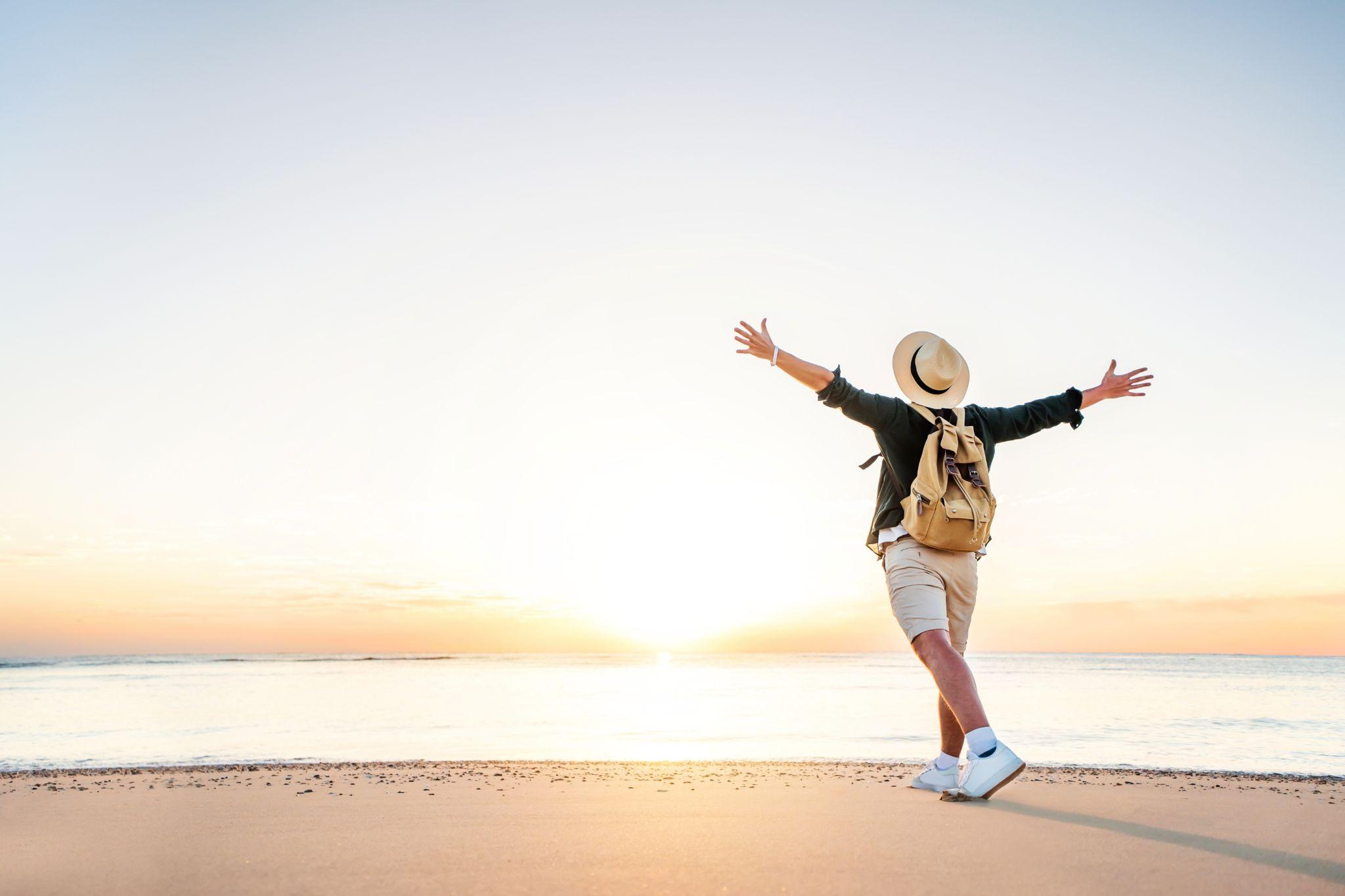
Our Addiction Resources
Navigating the world of addiction and recovery can be overwhelming. We’re here to provide clear, compassionate education and guidance. From practical advice for maintaining sobriety to informational guidance on the long-term effects of substance abuse, our content is a beacon of hope and understanding.
Our Team is Ready are ready to take your call
Call us Today!
or we can call you. Fill out form below
Our Blog

How to Talk to Family About Your Recovery Journey
Starting a conversation about your recovery journey with family can feel daunting. It’s natural to feel apprehensive about how they might react, or unsure about the right words to use. However, opening up and talking with family can play a vital role in the healing process, not just for you but for them as well. By sharing your journey, you invite understanding, strengthen bonds, and create a foundation of trust that supports your growth and resilience.
Why It’s Important to Share Your Recovery Journey with Family
The recovery process can be overwhelming for everyone, but open communication is essential. Family members can become a source of strength. When both sides dive deep into family relationships and nurture them with compassion and understanding, they create a space where all voices are heard and hearts are understood—a place for healing. This commitment marks the start of a journey toward stronger, more united family ties, vital for reinforcing support during recovery.
Below are some key ways that including family in your recovery journey can foster healing and mutual support for everyone involved, creating a stronger family recovery process:
Building a Supportive Network
A support network includes everyone involved in your recovery journey: medical professionals, support groups like NA or AA, a sponsor, and sober peers from rehab who have supported you and will continue to do so in aftercare programs. However, the most precious part of this network is the reassurance that comes from having a close-knit family who truly has your back. This safety net of invested individuals creates a solid foundation for rebuilding your life.
Rebuilding Trust
Addiction often strains trust within families, creating barriers that can linger long after recovery begins. Sharing your recovery journey with family members is a meaningful step toward rebuilding this trust, as it demonstrates accountability and commitment to change. Openly acknowledging past pain and showing a willingness to communicate honestly helps family members see your dedication to repairing relationships. This shared journey allows everyone to begin healing together, restoring a foundation of trust that strengthens family bonds over time.
Reducing Feelings of Isolation
Recovery can feel like a solitary journey, and isolation can make it even harder to stay motivated. By sharing your experiences with family, you create a sense of connection that reminds you you’re not alone. Including loved ones in your journey brings a sense of belonging and support that can ease feelings of loneliness. When family members are aware of your challenges and achievements, they can offer encouragement and companionship, transforming recovery into a collective effort rather than a solo struggle.
Promoting Understanding and Empathy
Sharing your recovery journey with family allows them to gain a deeper understanding of the challenges you face, building a foundation of empathy. When family members truly grasp what recovery entails, they are more likely to respond with compassion and patience rather than judgment. This shared understanding transforms your relationship, helping to create a supportive environment that can make the path to recovery feel less isolating and more hopeful for everyone involved.
How to Prepare for the Conversation
Opening up to family about your recovery journey can be one of the most difficult conversations you’ve ever had. However, by pushing through with honesty and openness, you can repair broken bonds. Here’s how to prepare for your conversation:
Know Your Goals
Clarify what you want to convey and the support you seek. Acknowledge any hurt you may have caused. Clear goals help you stay focused, reduce misunderstandings, and give your family a better idea of how they can support you.
Pick the Right Time and Place
Timing and setting can significantly impact how well a conversation is received. To avoid stress-induced reactions, choose a calm, private location and a time when everyone is unhurried and can focus without distractions. This allows for thoughtful responses and follow-up questions.
Manage Expectations
Understand that reactions may vary, and some family members might need time to process. Some may persist with fruitless questions, hoping for a different answer based on their own emotions, experiences, and knowledge of addiction. By accepting that reactions might differ, you allow space for a more open, ongoing dialogue and reduce the risk of initial disappointment.

Tips for Communicating Effectively About Your Recovery
During recovery you might feel shattered by confusion as intense feelings of guilt and anxiety arise as you try to find a way forward. Your family is probably trying to appreciate your struggles and support you without becoming codependent or trying to fix you. These tips can help you communicate effectively with your loved ones:
Be Honest and Direct
Being open about your experiences and progress demonstrates your commitment to growth. This honesty helps your loved ones understand your journey. Family support boosts self-worth, enhancing optimism and coping skills during recovery.
Focus on Your Feelings
Using “I” statements is a powerful way to express your thoughts and emotions without blame. For instance, saying, “I sometimes feel overwhelmed and alone in this journey” or “I feel encouraged when I know I have support” can help loved ones understand your perspective. This approach invites family members to be more receptive to your needs, fostering open and empathetic communication.
Acknowledge Past Mistakes
Addressing past mistakes is sensitive and intimidating but essential for long-term growth. Acknowledging responsibility for any hurt caused shows maturity and accountability. Equally important is emphasizing your commitment to change and looking forward rather than dwelling on the past.
How to Keep the Communication Going
Ongoing communication helps strengthen the bond with your family in recovery, fostering a supportive environment for everyone involved. Here are ways to keep that communication going:
Have Regular Check-Ins
Setting up regular check-ins with family members and other support figures can keep everyone informed and engaged—simple, honest conversations about how you’re feeling. You might be battling fears like, “What if I fail?” or “What if I disappoint my family?” Check-ins also create a sense of accountability, helping you stay focused and connected to your recovery goals.
Attend Family Therapy
With a therapist’s guidance, families can address unresolved issues, express concerns, and build healthier communication. A therapist encourages engaging with negative emotions and making amends instead of letting things simmer. Setting boundaries is crucial, explaining what support is helpful and what isn’t.
Celebrate Recovery Milestones Together
Recovery is marked by meaningful milestones, both big and small. Celebrating these achievements with family and friends is incredibly rewarding. Whether it’s a week, month, or year of sobriety, these milestones remind you of your hard work and progress. Involving loved ones in these celebrations reinforces the support and positivity they bring to your journey.
Family Therapy at Lumina Recovery
Lumina Recovery’s evidence-based programs include family therapy, addressing the emotional and psychological impact of addiction. We offer a comprehensive approach to family therapy for addiction, considering everyone’s journey.
Reach out to our compassionate team today and let us guide you with our holistic approach to healing your relationships during recovery.

The Dangers of Gas Station Heroin
When you step into a gas station, the last thing you expect to find on the shelf is an addictive and dangerous drug. Yet, in many parts of the United States, you might encounter a substance known as “gas station heroin.” This drug, tianeptine, has increasingly appeared in gas stations and convenience stores across the country.
Sold as a dietary supplement, tianeptine is marketed as a brain booster or a mood enhancer, but this product is anything but safe. Tianeptine binds to the same receptors in the brain as opioids, leading to similar addictive properties and dangerous side effects. Understand what gas station heroin is, the risks it poses, and the importance of getting help for those struggling with its use.
What Is Gas Station Heroin?
Gas station heroin is a nickname for tianeptine, a drug originally developed in France in the 1960s to treat depression. Unlike other antidepressants, tianeptine does not primarily alter serotonin levels. Instead, it affects the brain’s opioid receptors, producing effects similar to those of opioids like heroin and morphine.1
This unique mechanism of action is why tianeptine has such high addiction potential. While tianeptine is legally available in some countries by prescription, it is not a controlled substance and has never been approved by the U.S. Food and Drug Administration (FDA). Despite this, some companies have exploited a legal loophole by labeling tianeptine as a “dietary supplement,” allowing it to be sold over the counter and online in many states.
Tianeptine is often compared to heroin because of its addictive properties and its effects on the brain. Though it doesn’t contain heroin, the name “gas station heroin” arose because of its similarity in producing euphoria, pain relief, and eventual dependency.
Like other opioids, tianeptine can lead to a dangerous cycle of addiction. Users often experience intense withdrawal symptoms when they attempt to stop, causing them to continue using the drug to avoid these discomforts.
Dangers Surrounding Gas Station Heroin
While it may seem harmless on a convenience store shelf, gas station heroin carries significant risks that can severely impact both physical and mental health.
Health Risks and Side Effects
Users may experience side effects of gas station heroin such as nausea, vomiting, drowsiness, confusion, rapid heartbeat, and respiratory depression. At high doses, tianeptine can severely impair breathing, just like other opioids.1
In recent years, calls to poison control centers regarding tianeptine have significantly increased, reflecting a growing number of individuals experiencing adverse effects. Many cases have required hospitalization, with some users needing intensive care.1
The risk is especially high because many commercial products containing tianeptine have doses that are much stronger than therapeutic levels, often by as much as 100 times.1
Lack of Regulation and Content Risks
One of the main dangers of tianeptine is its lack of FDA regulation. Because tianeptine is sold as a supplement, it is not subject to the same standards as pharmaceutical drugs. This means the ingredients and dosages listed on product labels may not accurately represent the contents.
Additionally, these products may include harmful additives or fillers that increase the health risks. Without regulation, users risk taking inconsistent doses, which can easily lead to overdose.
Addiction and Withdrawal
Gas station heroin poses a high risk of addiction. Like other opioids, tianeptine can lead to physical dependence, meaning users need more of the drug over time to achieve the same effect.
When someone becomes dependent on tianeptine, they will likely experience severe withdrawal symptoms if they try to stop. Withdrawal from tianeptine is similar to withdrawal from opioids and may include symptoms such as nausea, muscle pain, sweating, agitation, and insomnia.2
These symptoms can drive users to continue using the drug to avoid the discomfort of withdrawal, creating a vicious cycle of addiction. The potential for dependence is so strong that people may engage in “doctor shopping” or attempt to acquire multiple prescriptions if they are in a country where tianeptine is prescribed.
Legal Risks and State Regulations
While tianeptine is not federally regulated in the United States, awareness of its dangers is growing. Some states, including Alabama, Florida, and Mississippi, have banned tianeptine, making it illegal to sell or possess. These states took action after observing the drug’s effects on public health, particularly the rise in addiction cases and hospitalizations linked to tianeptine.1
The FDA has issued warnings about tianeptine and its associated products, urging consumers to avoid them altogether. However, due to its current legal status in many states, tianeptine remains widely available in gas stations, convenience stores, and online.

Getting Help for Gas Station Heroin Addiction
Recovering from gas station heroin addiction is challenging, but with the right support and resources, a path to healing and stability is within reach.
Recognizing the Signs of Addiction
If you or a loved one is struggling with tianeptine use, recognizing the signs of addiction is essential. Signs may include increased use of the drug, a strong craving to use it, and experiencing withdrawal symptoms when not using it.
Behavioral signs, such as withdrawing from social activities, neglecting responsibilities, and spending excessive amounts of money to obtain the drug, may also indicate a growing addiction.
Seeking Professional Support
Overcoming addiction to gas station heroin is challenging, but support is available. Addiction specialists trained in opioid use disorder and synthetic drug dependencies can provide the necessary help.
Professional treatment often begins with detox programs that help individuals safely manage withdrawal symptoms. In some cases, medication-assisted treatment (MAT) is used to relieve withdrawal symptoms and reduce cravings, making the recovery process more manageable.
Long-Term Recovery Options
Recovering from tianeptine addiction is not just about stopping the drug but about creating a healthy, sustainable lifestyle. Many recovery programs provide ongoing support to help individuals navigate their post-addiction journey. These programs may include therapy sessions, counseling, and support groups that address the emotional and mental aspects of addiction.
Lifestyle changes, such as building healthy coping mechanisms and learning stress management skills, are often part of these programs. By equipping individuals with long-term strategies for handling life’s challenges, these programs play a vital role in preventing relapse.
Find Support and Safety in Recovery With Lumina Recovery
Gas station heroin, or tianeptine, is a dangerous substance posing serious risks, from addiction to life-threatening health issues. Understanding these dangers is crucial, especially as unregulated supplements like tianeptine continue to appear in stores across the country. At Lumina Recovery, we’re here to help individuals navigate these challenges safely and effectively.
Our detox program offers a secure environment for managing withdrawal symptoms, while our dual diagnosis services address both addiction and any underlying mental health concerns that may accompany it.
If you or a loved one needs guidance in overcoming tianeptine or any other addiction, reach out to Lumina Recovery. Our compassionate team is ready to provide the support and tools you need to start a healthier, addiction-free life.
Sources:

Low-Stress Careers for a Healthier Lifestyle
Navigating life in recovery means prioritizing choices that support both mental and physical well-being. While we might think of recovery as limited to therapy, treatment plans, and support groups, career choices can play a significant role too.
For those who have experienced addiction, high-stress work environments can increase vulnerability to triggers that may lead to relapse. Conversely, choosing a low-stress career can promote a balanced and fulfilling lifestyle, making it easier to sustain recovery.
The Impact of Stress on Addiction and Recovery
Chronic stress is an invisible force that gradually wears down both the mind and body. Long-term exposure to stress can lead to a host of mental and physical health issues, from anxiety and depression to cardiovascular problems. People under constant stress might seek ways to escape or relieve that pressure, sometimes turning to substances or behaviors that provide temporary relief but can lead to dependence or addiction.
In addiction recovery, stress is often a primary trigger for relapse. Those in recovery need a lifestyle that minimizes stress and that often includes their work environment. Careers with intense demands, unpredictable hours, or high-stakes responsibilities may amplify stress levels, potentially risking relapse or mental health setbacks. Shifting to a career with manageable expectations, steady hours, and a supportive environment can encourage stability.
Recovery is a holistic journey. Many in recovery find that their work environment plays a significant role in maintaining a balanced life. A low-stress career can help support mental clarity, provide a sense of purpose and job satisfaction, and make it easier to set healthy boundaries.
14 Low-Stress Careers for a Healthier Lifestyle
If you or someone you love is in recovery, here are several low-stress job options that can support a day-to-day lifestyle of balance and mental peace:
1. Librarian
A career in libraries offers a quiet, slow-paced, controlled environment with a predictable schedule and minimal physical demands. Librarians typically work within clear boundaries, which helps in setting routines and avoiding stressors associated with high-demand jobs.
2. Gardener/Landscaper
For those who find peace in nature, gardening or landscaping offers a calming, outdoor experience. Working with plants, cultivating growth, and spending time outdoors can be rewarding and physically beneficial. These roles allow for a flexible schedule, promoting balance.
3. Freelance Writer
Writing freelance provides creative expression and flexibility in workload. Freelancers can often work from home and set their own schedules, reducing stress that may come from commuting, workplace politics, or rigid office hours.
4. Medical Records Technician
This role allows individuals to work behind the scenes in a structured environment. Medical records technicians maintain records and data for healthcare providers, requiring attention to detail but with limited patient or public interaction, which helps in keeping the role stress-free.
5. Data Entry Specialist
Data entry is straightforward and often repetitive, which can be a positive aspect for those looking to avoid high-stakes work. Many data entry positions allow for remote work, adding another layer of flexibility and convenience.
6. Massage Therapist
Massage therapists work in peaceful, calm environments and typically deal with one client at a time. The work itself is therapeutic and focuses on creating relaxation, which can positively impact the therapist’s mental state as well. For many, this role offers a work-life balance that is less common in more traditional careers.
7. Graphic Designer
Creativity can be a powerful tool for self-expression, and graphic design allows flexibility and creativity. Many graphic designers work as freelancers or with small agencies, making it possible to create a balanced and manageable workload that aligns with personal recovery goals.

8. Bookkeeper
Bookkeeping involves working with numbers in a structured, focused environment. Bookkeepers often work independently, completing tasks that require attention to detail without the added stress of customer-facing or high-pressure scenarios.
9. Physical Therapist
Physical therapists work in one-on-one settings, helping clients improve their mobility and strength. The work is hands-on and fulfilling, focusing on patient progress rather than fast-paced deadlines, making it a rewarding, lower-stress career path.
10. Museum or Gallery Attendant
Working in a museum or art gallery offers a calm environment with minimal demands. The job often involves supervising exhibits and assisting visitors, making it a good choice for those who appreciate art and want a quieter workplace.
11. Dietitian or Nutritionist
Many dietitians and nutritionists work one-on-one with clients, providing advice on diet and nutrition. This career path focuses on promoting wellness, which can be rewarding, and it generally offers low levels of stress and flexible scheduling options.
12. Pet Care Worker or Dog Walker
Working with animals is therapeutic for many. Dog walking, pet sitting, or working in animal care shelters allows individuals to spend time with animals, offering a calming and fulfilling experience with minimal stress.
13. Yoga Instructor or Fitness Trainer
Fitness instructors, especially those in areas like yoga or Pilates, work in relaxing environments that emphasize wellness. Instructors have control over their schedules and work environments, making this a supportive choice for mental health.
14. Remote Customer Service Representative
Many companies now offer remote customer service positions with flexible hours. Remote roles provide the comfort of working from home and reduce stress by eliminating the need for a commute and providing a better work-life balance.
Why Some in Recovery Consider Low-Stress Careers
While changing careers can feel daunting, many in recovery find that making this shift helps them maintain stability and improve their mental health. Recovery often involves lifestyle adjustments, and career changes may be one of them.
Transitioning to a lower-stress career can be a proactive choice to build a sustainable future. Low-stress roles are often conducive to setting boundaries, maintaining a routine, and limiting exposure to high-pressure situations, all crucial to staying focused on recovery.
For those in early recovery, considering a low-stress career can be a strategic step in supporting long-term goals. Many find that a job with lower demands allows them to focus on personal growth, regain a sense of autonomy, and explore what a balanced lifestyle truly means.
Pursue a Healthier, Balanced Life With Lumina Recovery
Choosing a low-stress career path can be a transformative step in living a balanced life, especially for those on a recovery journey. Finding meaningful work that promotes calm and stability is just one way to support lasting sobriety and mental health.
At Lumina Recovery, we’re here to help you explore all aspects of a healthy recovery journey, offering dual diagnosis treatment to address co-occurring conditions like anxiety or stress, and outpatient programs for ongoing support that fits around your schedule.
Ready to take the next step in building a fulfilling, healthier life? Contact us today to learn how we can support you.

Adjustment Disorder and Its Link to Addiction
Adjustment disorder is a mental health condition that can develop in response to challenging life events, causing emotional and behavioral symptoms like sadness, anxiety, and social withdrawal.
For some people, these symptoms can feel overwhelming, leading them to seek relief in unhealthy ways, such as substance use. When someone with adjustment disorder starts using drugs or alcohol to cope, the risk of addiction increases and the two conditions can quickly become intertwined.
Understanding adjustment disorder and its connection to addiction can empower those struggling or their loved ones to seek the help they need to find lasting solutions.
What Is Adjustment Disorder?
The Diagnostic and Statistical Manual of Mental Disorders (DSM-5) says adjustment disorder is a group of symptoms that occur as a reaction to stress that arises when someone has difficulty coping with something like a stressful event or life change.1
These symptoms vary from person to person but typically start within three months of the triggering event and are often more intense than what might be expected in response to the event, causing distress that affects daily functioning.
Subtypes of Adjustment Disorder
The types of adjustment disorders are categorized based on predominant symptoms, which provide insights into the primary emotional or behavioral response to the stressor:2
- Adjustment Disorder with Depressed Mood: Shown by tearfulness, feelings of sadness, and hopelessness as a predominant response.
- Adjustment Disorder with Anxiety: Manifests through nervousness, excessive worry, jitteriness, or separation anxiety.
- Adjustment Disorder with Mixed Anxiety and Depressed Mood: Combines both depression and anxiety symptoms, resulting in a complex emotional state.
- Adjustment Disorder with Disturbance of Conduct: Shows predominantly behavioral issues, like impulsivity, defiance, or risky actions.
- Adjustment Disorder with Mixed Disturbance of Emotions and Conduct: Involves both emotional symptoms (such as depression and anxiety) and behavioral disturbances.
- Adjustment Disorder Unspecified: Used for maladaptive responses that do not fit any specific subtype.
Common Triggers of Adjustment Disorder
Adjustment disorder can develop from various life changes or stressors. These triggers for adjustment disorder may include:3
- Death of a loved one
- Divorce or relationship issues
- Life transitions
- Health issues
- Financial stress
Triggers in younger people may differ but can include family conflicts, school stress, or navigating personal identity issues, like sexuality. No single event or life change can predictably lead to adjustment disorder, as everyone’s capacity to cope with stress varies.
Symptoms of Adjustment Disorder
The symptoms people experience with the disorder are intense enough to impact a person’s social, professional, or personal life. These symptoms of adjustment disorder include:3
- Emotional Symptoms: Individuals may feel persistently sad, hopeless, or anxious. Many may cry frequently or withdraw from social interactions.
- Behavioral Symptoms: Some people exhibit defiant or impulsive behaviors, reflecting a struggle to process their emotions.
- Physical Symptoms: Physical signs of stress can include nervousness, skipped heartbeats, trembling, or muscle tension.
To meet the criteria for adjustment disorder, these symptoms must be more intense than expected for the type of event that triggered them and should not be due to another mental health condition. In severe cases, individuals may have thoughts of self-harm or suicide, signaling a need for immediate support.

The Link Between Adjustment Disorder and Addiction
When symptoms of adjustment disorder persist, the emotional toll can feel unbearable. For many, substances like drugs or alcohol seem to offer quick relief, numbing difficult feelings or providing a temporary escape. However, using substances as a coping tool can quickly lead to dependency, as the temporary relief fuels continued use.
Coping Mechanisms and Substance Use
People with adjustment disorder may turn to substances as a means of self-medicating. The sadness, anxiety, or stress associated with adjustment disorder can feel all-consuming, and substances appear to ease these symptoms in the short term. Unfortunately, these coping mechanisms create a pathway to addiction, as the brain starts associating substance use with relief.
Risk Factors for Addiction
Adjustment disorder can increase susceptibility to addiction because of the emotional instability it causes. Since the disorder impairs one’s ability to manage stress, those struggling with it may find that they lack healthy coping skills. This vulnerability, combined with the intense need to alleviate pain, can lead someone down the path of addiction more quickly than those without adjustment disorder.
The Escalating Cycle of Addiction and Adjustment Disorder
The relationship between the two often forms a vicious cycle. When someone uses substances to cope, they might initially feel relief, but the side effects of substance use and the potential for withdrawal symptoms can worsen their emotional state. This often results in an increased reliance on the substance, creating a cycle that is difficult to break without professional intervention.
Importance of Dual Diagnosis in Treatment
Dual diagnosis is a treatment approach designed for individuals who face both a mental health condition and a substance use disorder. This integrated approach is critical for people dealing with adjustment disorder and addiction, as it addresses the complex interaction between both conditions. Effective treatment for dual diagnosis considers how each condition influences the other to create a tailored approach that can help break the cycle.
Dual diagnosis treatment from mental health professionals can significantly improve outcomes for people dealing with both adjustment disorder and addiction, by treating the root causes of both issues. This approach may include:
- Cognitive Behavioral Therapy (CBT): CBT helps individuals identify and alter thought patterns that contribute to emotional distress and addictive behaviors. By understanding these thought processes, individuals can build healthier coping skills and responses to stress.
- Medication Management: In some cases, medication can help manage symptoms of anxiety or depression associated with adjustment disorder, easing the intensity of these emotions and reducing the need for substances as a coping mechanism.
- Group Therapy and Peer Support: Peer support and group therapy create a safe place for individuals to share their experiences, learn from others, and feel less isolated in their struggles.
Addressing both conditions through dual diagnosis allows for a holistic view of recovery. By managing the emotional symptoms of adjustment disorder and treating the addictive behaviors associated with substance use, dual diagnosis gives individuals the tools they need to work through their issues simultaneously, promoting long-lasting recovery.
Take the Next Step Toward Recovery With Lumina Recovery
Adjustment disorder can be a difficult condition to face, especially when it intensifies emotions to the point where substance use becomes a means of coping. However, understanding this connection and seeking dual diagnosis treatment can make a significant difference in recovery.
Lumina Recovery offers dual diagnosis treatment for mental health issues like anxiety, PTSD, and depression, alongside addiction treatment, providing a balanced approach that addresses the roots of each condition.
Reach out to Lumina Recovery today to begin a path toward lasting healing and well-being from adjustment disorder and addiction.
Sources:

Addiction vs. Dependence: Understanding the Difference
Understanding the difference between dependence and addiction can be challenging, yet it’s crucial, especially for those dealing with substance use issues, as well as their loved ones offering support. These terms are often used interchangeably, but they describe distinct experiences with substance use.
The term dependence refers primarily to a physical reaction, where the body adapts to a substance. The word addiction, however, includes psychological factors and drives compulsive behavior despite harmful consequences. Recognizing these differences is a vital first step in addressing substance use disorders effectively.
What Is Dependence?
Dependence occurs when the body becomes accustomed to a substance, requiring more of it over time to achieve the same effects. This process is known as tolerance. Alongside tolerance, dependence can also lead to withdrawal symptoms when the substance use is reduced or stopped.
Tolerance develops as the body adjusts to a substance, so it needs larger doses to achieve the original effect. For example, someone using prescription painkillers may find they need higher doses over time to manage pain.
When the body has a dependence on a drug, stopping or reducing the substance can trigger withdrawal symptoms. These symptoms vary depending on the substance. For alcohol, withdrawal can include side effects like sweating, shaking, and even seizures in severe cases.
Dependence can be physical, psychological, or a combination of both. Physical dependence involves bodily changes that create withdrawal symptoms when stopping the substance. Psychological aspects of dependence involve cravings or a mental need for the substance, and psychological withdrawal is also possible.
For example, someone may be physically dependent on anxiety medication, feeling discomfort if they stop, and also feel mentally dependent on it to manage stress.
What Is Addiction?
Addiction is more than physical dependence. It is a chronic disorder that affects the brain and behavior, leading to compulsive substance use despite harmful consequences. Addiction involves changes in brain function that make it challenging to control urges, and people may prioritize the substance above other aspects of life.
The main addictive behavior is the inability to control substance use. This means the person struggles to limit their use, even if they want to or when it causes problems in their life.
Drug addiction often disrupts various areas of life, such as health, relationships, work, and personal well-being. Despite knowing the damage it causes, the individual finds it difficult to stop using. Addiction creates strong cravings and compulsions, making it nearly impossible to focus on anything besides obtaining and using the substance.
While addiction is often linked to substances like drugs and alcohol, it can also apply to behaviors. Behavioral addictions, such as gambling, may not involve a substance but can show similar compulsive patterns and life-impacting consequences.
Dependence vs. Addiction: How They Differ
While dependence and addiction share similarities, there are key differences.
Dependence involves physical changes, but it doesn’t always include the compulsive, uncontrollable behavior seen in addiction. For instance, a patient may be physically dependent on prescribed medications yet use them responsibly. Dependence does not always interfere with daily life in the way addiction does.
A dependent individual might experience physical symptoms without serious disruptions to their social or work life. In contrast, addiction and substance abuse often affect multiple life areas, leading to ongoing issues.
Imagine a person who is physically dependent on a prescription painkiller, using it responsibly as prescribed by their doctor. They experience withdrawal symptoms if they stop, but they aren’t addicted. On the other hand, someone using opioids recreationally, facing negative outcomes, and struggling to stop despite those harms, may be considered addicted.
Relationship Between Dependence and Addiction
While dependence does not equal addiction, it can become a precursor to addiction if misuse or abuse occurs. For example, when a person misuses a prescribed medication or begins using more than necessary, their dependence can escalate into addiction. This progression isn’t inevitable, but the risk increases if substances are used outside of medical guidelines.
Awareness of dependence can help prevent addiction and drug abuse. Understanding tolerance and withdrawal can signal that the body is adjusting to a substance, providing a chance to pause, reassess, and, if needed, seek medical guidance. Early recognition of these signs and taking steps to avoid misuse may reduce the risk of developing an addiction.

Treatment Considerations
Treatment for dependence and addiction requires tailored approaches that address the unique challenges of each condition:
Dependence Treatment
- Tapering Approach: Dependence is often managed by gradually reducing substance use under medical supervision to ease withdrawal symptoms.
- Medical Supervision: Healthcare providers create a safe, sustainable tapering plan, minimizing discomfort and ensuring a steady adjustment for the body.
- Effective Management: With professional guidance, dependence can be treated effectively, focusing on safely reducing reliance without distress.
Addiction Treatment
- Detoxification: Treatment usually begins with detox in a supervised setting to address withdrawal symptoms
- Therapy and Counseling: Cognitive behavioral therapy (CBT) or dialectical behavior therapy (DBT) can help address the thought patterns and behaviors driving substance use.
- Support Groups: Community support, like 12-step programs, offers accountability and a shared space to discuss challenges and successes with others who understand.
- Medication-Assisted Treatment (MAT): For substances like opioids or alcohol, MAT (e.g., methadone, buprenorphine, or naltrexone) can help manage cravings and withdrawal when paired with counseling.
Family and Community Support
- Family Involvement: Addiction impacts everyone around the individual, so involving loved ones in therapy strengthens relationships and builds a support network.
- Educational Resources: Offering resources to loved ones improves understanding, creating an environment that supports recovery and helps prevent relapse.
Long-Term Management
- Ongoing Support: Addiction often requires ongoing management, with counseling, group meetings, and aftercare services offering essential support.
- Building Healthy Coping Mechanisms: Learning to manage cravings, avoid triggers, and adopt healthier coping skills is essential for sustained recovery and a balanced lifestyle.
Start Your Journey to Health and Healing With Lumina Recovery
Understanding the difference between dependence and addiction is crucial for choosing the right path to recovery. Dependence centers on the body’s adaptation to substances, while addiction is marked by a powerful compulsion that affects all aspects of life.
At Lumina Recovery, our detox and dual diagnosis programs are specifically designed to address both physical and mental health needs, helping individuals safely withdraw from substances.
If you or someone you know is ready to make a change, get in touch with our compassionate support today.

What Is Wet Brain? Symptoms, Causes, and Treatment
Wet brain, or Wernicke-Korsakoff syndrome (WKS), is a brain condition that results from a deficiency in thiamine (vitamin B1), usually linked to alcohol abuse.
The National Institute on Alcohol Abuse and Alcoholism states that WKS frequently affects those with severe alcohol use disorder (AUD), though it’s not limited to alcohol misuse alone. Other medical conditions can also lead to this disorder, and researchers estimate that wet brain syndrome remains undiagnosed in approximately 80% of cases, underscoring the need for awareness and early intervention.1
What Is Wet Brain?
Wernicke-Korsakoff syndrome, commonly referred to as wet brain, is a neurological disorder that includes two stages: Wernicke encephalopathy and Korsakoff syndrome. While these stages of wet brain can appear separately, they often occur together as different points in the same disease.1
Wernicke encephalopathy typically arises suddenly and presents with acute symptoms that require immediate medical attention. If left untreated, it progresses to the more chronic and debilitating Korsakoff syndrome.
Both stages of wet brain are connected to a thiamine deficiency, disrupting the brain’s ability to produce energy. This lack of energy leads to brain function deterioration, potentially causing permanent cognitive damage if the condition is not addressed promptly.
Symptoms of Wet Brain
Wet brain symptoms appear in two stages, each with distinct and often overlapping indicators. Getting treatment after early detection is crucial to preventing wet brain from progressing into severe and irreversible stages.
Stage 1: Wernicke Encephalopathy
The initial stage of wet brain, Wernicke encephalopathy, is a medical emergency that requires immediate intervention. This stage typically develops quickly and is characterized by a range of serious neurological and physical symptoms.
As a result of thiamine deficiency, the brain struggles to convert nutrients into energy, causing cellular dysfunction that leads to both mental and physical symptoms.
During this early stage, patients may appear suddenly disoriented, confused, and disconnected from their surroundings. Without treatment, Wernicke encephalopathy can rapidly progress, leading to permanent damage in the brain and nervous system. Common symptoms include:1
- Confusion: Individuals may feel disoriented or detached from their surroundings, often struggling to focus or engage.
- Loss of muscle coordination: Tremors, an unsteady gait, and muscle weakness make standing or moving independently challenging.
- Vision problems: Rapid eye movement, drooping eyelids, or double vision can impair sight and affect daily functioning.
- Cardiovascular issues: Drowsiness, fainting spells, low blood pressure upon standing, and a faster heart rate are also common, further complicating the physical impact.
Stage 2: Korsakoff Syndrome
If Wernicke encephalopathy is left untreated or inadequately managed, it often advances to the chronic phase known as Korsakoff syndrome. In this stage, brain damage becomes extensive, leading to long-term impairments that resemble those found in other forms of dementia.
Korsakoff syndrome is distinguished by significant cognitive impairments, making it difficult for individuals to retain new information or recall recent events.
Symptoms can be severe, and while some individuals may experience partial improvements, the impact on cognition and memory is often long-lasting. Key symptoms include:1
- Memory impairment: This includes memory loss, especially affecting short-term recall, and an inability to remember recent conversations or experiences.
- Problems forming new memories: The ability to retain new information is compromised, making it challenging for individuals to adapt to or remember current events.
- Confabulation: To fill memory gaps, individuals may unknowingly fabricate details or stories without realizing they are inaccurate.
- Lack of motivation and emotional apathy: Individuals may experience diminished motivation, showing little interest or emotional response to people or activities that once held significance.
Causes of Wet Brain
The primary cause of wet brain is thiamine deficiency, which impacts brain energy production, leading to memory impairment and other symptoms. While chronic alcohol consumption is the most common cause—impairing thiamine absorption, storage, and usage—other conditions can lead to wet brain syndrome, such as:2
- Eating disorders like anorexia
- Severe medical conditions like cancer, AIDS, or persistent infections
- Gastrointestinal surgeries such as gastric bypass
- Chronic vomiting or substantial weight loss
Individuals aged 45 to 65, people facing homelessness, and those with serious mental health challenges who may abstain from alcohol but face dietary restrictions are at higher risk of developing wet brain.2

Treatment for Wet Brain: Addressing a Form of Dementia
Treating wet brain involves both immediate and long-term approaches to reduce symptoms and manage complications. Wet brain is often considered a form of dementia because it causes severe memory loss and cognitive impairment. With swift intervention, certain symptoms can improve, but for many, long-term care and lifestyle changes are essential.
Immediate Treatment with Thiamine
The first step in treating wet brain is replenishing the body’s thiamine (vitamin B1) levels. Since wet brain results from a thiamine deficiency, restoring this vitamin is crucial. High-dose thiamine is typically administered through an IV for fast absorption, helping prevent further damage and stopping the condition from progressing to more severe stages.
Lifestyle Changes and Abstinence
Since alcohol consumption is a leading cause, long-term treatment also involves abstaining from alcohol to prevent worsening symptoms and support brain health.
Individuals are encouraged to adopt a nutrient-rich diet, as proper nutrition helps stabilize thiamine levels and overall health. Support from addiction treatment specialists, therapists, or support groups is often recommended to manage alcohol use disorder and maintain sobriety.
Memory and Cognitive Rehabilitation
Because wet brain impacts memory and cognitive function, memory rehabilitation therapies are essential, especially in cases where Korsakoff syndrome has developed. Cognitive therapies can help patients relearn how to form new memories and regain some independence, though results vary.
Long-Term Care and Support
In severe cases, individuals may require long-term residential care for ongoing supervision and specialized support. Residential programs provide a structured environment with continuous, tailored care for each patient’s needs. This type of care is especially helpful for those with advanced Korsakoff syndrome, where severe memory impairment and mobility issues are common.
Heal From Addiction With Lumina Recovery
Wet brain, or Wernicke-Korsakoff syndrome, is a serious condition that results from a lack of thiamine, most often due to chronic alcohol abuse. For those in recovery or their loved ones, understanding wet brain and seeking prompt treatment can help improve outcomes and support long-term healing.
Lumina Recovery offers therapy and alcohol use disorder programs to address the challenges of alcohol use, helping individuals regain control of their lives and support a path toward lasting sobriety.
If you or a loved one is struggling with alcohol use and its effects, reach out to Lumina Recovery for the support you need today.
Sources:

Finding Gratitude During Addiction Recovery
Addiction recovery is a journey that requires perseverance, patience, and hope. Along the way, individuals may face numerous challenges, but one of the most powerful tools that can aid in the healing process is the practice of gratitude. Gratitude is not just a fleeting feeling of thankfulness, but a deeper sense of appreciation for the good in life, no matter how small.
Learn why gratitude and addiction recovery are important, how to incorporate gratitude into daily life, and find specific ways to foster a sense of gratefulness that supports a fulfilling and long-lasting recovery. If you’re on the path to recovery or supporting a loved one, you’ll discover how recovery gratitude can be a transformative force.
Why Gratitude Is Important in Addiction Recovery
Gratitude plays a crucial role in addiction recovery because it shifts focus from what is lacking to what is present and positive. Addiction often leads to feelings of despair, guilt, and shame, which can make it difficult to maintain hope and motivation. However, when gratitude and recovery go hand in hand, it becomes easier to focus on progress and growth, rather than setbacks. Here’s why gratitude is important in recovery:
Positive Mental Shift
Practicing gratitude in recovery encourages individuals to shift their mindset from negativity to positivity. Instead of focusing on what was lost during addiction, such as relationships or opportunities, gratitude helps them acknowledge what they are regaining—like health, clarity, and new connections.
Improved Mental Health
Gratitude and recovery are closely linked to mental well-being. People who regularly practice gratitude may experience lower levels of depression and anxiety. A grateful recovery encourages feelings of contentment, which can reduce the risk of relapse.1
Strengthened Relationships
Addiction often isolates people, but recovery is a time to rebuild connections. Gratitude can help individuals appreciate the support they receive from family, friends, and mentors. Acknowledging the value of these relationships can deepen bonds and create a stronger support system.
Enhanced Resilience
When things get tough during recovery, gratitude acts as an anchor. It allows individuals to find strength in the small victories and the good things happening in their lives, even when the journey feels overwhelming.
7 Ways to Find Gratitude in Addiction Recovery
Developing gratitude is a practice, one that can be nurtured and grown over time. Below are ways to cultivate gratitude during addiction recovery that will help sustain a positive and resilient outlook.
1. Start a Gratitude Journal
An easy way to bring gratitude into your daily life is by keeping a gratitude journal. Begin each day by noting a few things you appreciate. These can be small or big, ranging from having a safe place to sleep to the progress made in therapy. Writing things down helps reinforce positive thinking and creates a personal list of things to be grateful for, which you can revisit when recovery feels challenging.
2. Reflect on Personal Growth
Recovery is a time of personal transformation, and reflecting on how far you’ve come can spark a deep sense of gratitude. Whether it’s celebrating a milestone, like one month of sobriety, or acknowledging how you’ve handled a difficult situation with strength, take time to reflect on the ways in which you’ve grown. Finding gratitude in recovery often starts with recognizing and appreciating your own journey.
3. Practice Mindfulness
Mindfulness is a valuable tool in both addiction recovery and cultivating gratitude. By focusing on the present moment, mindfulness allows you to appreciate the here and now, free from past regrets or future worries. Practicing gratitude through mindfulness can be as simple as appreciating a quiet moment of peace, the warmth of the sun, or the sound of birds outside. Being mindful helps you see the beauty in everyday life.

4. Express Gratitude to Others
Recovery is not a solitary journey. It’s often supported by loved ones, therapists, or support group members. Take time to express your gratitude to the people who have helped you along the way. Whether it’s writing a thank-you note or saying “thank you” in person, expressing gratitude strengthens relationships and fosters a sense of connection. This acknowledgment is not only beneficial for you but it also creates a cycle of gratitude that can uplift others.
5. Focus on What You Can Control
Addiction can make life feel chaotic and out of control. During recovery, focusing on what you can control—like your actions, choices, and mindset—can bring a sense of empowerment and gratitude. Being grateful for the ability to choose sobriety, engage in self-care, or reach out for help is a small but significant act that reinforces your commitment to recovery.
6. Celebrate the Little Wins
Addiction recovery is a series of small, daily successes. Acknowledge and celebrate these moments, whether it’s resisting a craving, attending a support group, or simply waking up feeling positive. By appreciating these little wins, you create a mindset that looks for reasons to be grateful every day, even when the bigger goals feel far away.
7. Create a Gratitude Jar
For a more interactive approach to gratitude, consider starting a gratitude jar. Each day, write down something you’re grateful for on a slip of paper and place it in the jar. Over time, the jar will fill with moments of gratitude that you can look back on whenever you need encouragement or motivation. This practice helps you see the accumulation of positive experiences, reinforcing the power of recovery gratitude.
Ready to Get Addiction Treatment With Lumina Recovery?
Gratitude is more than just an emotion—it’s a powerful practice that can support long-term recovery. By focusing on the things to be grateful for, both big and small, you can nurture a positive mindset that sustains you on the path to healing.
At Lumina Recovery, our therapy and specialized programs are designed to foster personal growth, resilience, and healing, helping individuals incorporate gratitude into their recovery journey for a more fulfilling and sustained sobriety.
Reach out to Lumina Recovery today to start your journey toward healing and a grateful recovery.
Source:

Your Guide to Alcohol-Associated Liver Disease
Alcohol consumption is a common part of social life in the United States, but whether excessive or binge drinking occurs, it can take a severe toll on the body, particularly the liver. Alcohol-associated liver disease (ALD) is a direct result of long-term, excessive drinking.
For people with alcohol addiction or for loved ones who are concerned, understanding the risks and consequences of alcohol and liver disease is essential. Early intervention and recovery are crucial to preventing irreversible damage.
What Is Alcohol-Associated Liver Disease?
Alcohol-associated liver disease refers to a range of conditions that result from prolonged alcohol abuse. The three types of liver disease range in severity and include fatty liver, alcoholic hepatitis, and cirrhosis:1
1. Fatty Liver (Steatosis)
This is the earliest stage of alcohol-related liver disease. It occurs when fat builds up in the liver due to excessive drinking. At this stage, there may not be any noticeable symptoms, but the damage is already happening. Fortunately, fatty liver can be reversed if any amount of alcohol use is stopped early enough.
2. Alcoholic Hepatitis
If one doesn’t stop drinking alcohol, inflammation of the liver, known as alcoholic hepatitis, may develop. Symptoms of alcoholic hepatitis include jaundice (yellowing of the skin and eyes), abdominal pain, nausea, and vomiting. This stage of liver disease is more severe than fatty liver and may require medical intervention.
3. Cirrhosis
The most advanced form of ALD is cirrhosis. This is when healthy liver tissue is replaced by scar tissue, which impairs the liver’s ability to function. At this stage, liver damage is often irreversible, and the risk of liver failure, cancer, and death increases significantly.
How Is Alcohol-Associated Liver Disease Caused?
To understand how alcohol harms the liver, it’s important to first know the liver’s key role in overall health. Located on the right side of the abdomen beneath the ribs, the liver performs vital functions, such as producing bile to help digest fats, metabolizing nutrients like carbohydrates, fats, and proteins, and producing necessary substances for blood clotting. Additionally, the liver acts as a filter, removing harmful toxins—including alcohol—from the bloodstream.2
When alcohol is consumed, it travels from the stomach and intestines into the bloodstream and is then transported to the liver. The liver breaks down alcohol using enzymes, but this process creates harmful byproducts that can damage liver cells.
A heavy drinker may have a buildup of fat within the liver, which can interfere with its normal function. Over time, this process also triggers inflammation and fibrosis, a condition where scar tissue forms in the liver.2
As a result, the liver becomes less capable of performing its essential functions, such as filtering toxins and metabolizing nutrients. People who drink continuously worsen this damage, often leading to advanced liver diseases such as hepatitis or cirrhosis.2

Why Recovery Is Important Now
Recognizing alcohol-induced liver damage is a vital first step. However, the urgency of taking action cannot be overstated. Here are some reasons why recovery from alcohol abuse is crucial right now:
Liver damage worsens over time. Even if someone isn’t experiencing severe symptoms yet, the disease may be advancing. The earlier someone stops drinking, the more likely they are to prevent permanent damage. For those in the early stages of fatty liver or mild alcoholic hepatitis, stopping alcohol use can reverse much of the damage.
Reducing the risk of complications. Alcohol-associated liver disease doesn’t just affect the liver. It increases the risk of other serious health problems like liver cancer, kidney failure, and cardiovascular issues. The sooner someone stops drinking, the more they lower their risk for these life-threatening complications.
Improved quality of life. Living with advanced liver disease can be painful and debilitating. Symptoms like fatigue, abdominal pain, and jaundice can severely impact daily life. Recovery not only prevents the worsening of these symptoms but can also lead to a noticeable improvement in overall well-being.
Avoiding irreversible damage. Once cirrhosis develops, liver function is significantly impaired, and the damage is often permanent. Early intervention through stopping alcohol consumption is essential to avoid reaching this point of liver failure or even a liver transplant. For those who already have cirrhosis, quitting drinking can prevent further damage and give the liver a chance to function as well as possible.
Taking the First Steps Toward Recovery
Deciding to stop drinking and start recovery is a difficult but life-saving decision. Here are some steps to begin the process:
1. Seek Medical Help
It’s crucial to see a healthcare provider, especially if liver disease is suspected. Doctors can run tests like CT scans to assess the extent of liver damage and recommend appropriate treatments. Detoxing from alcohol should be done under medical supervision, as withdrawal can be dangerous without professional support.
2. Find a Support System
Recovering from alcohol addiction is challenging, but having a support network of family, friends, and professional counselors can make a world of difference. Whether it’s through group therapy, individual counseling, or a structured rehabilitation program, support is essential for long-term success.
3. Adopt a Healthy Lifestyle
A balanced diet, regular exercise, and mental health care are all key components of a healthy recovery. Since alcohol has likely taken a toll on the body, focusing on nutrition and self-care will help the liver heal and improve overall health.
4. Stay Committed
Recovery is a long-term process that requires ongoing commitment. Even after the initial detox and early stages of recovery, individuals will need to stay vigilant to avoid relapse. Maintaining a structured routine, avoiding triggers, and continuing therapy are all important strategies for staying on the path to sobriety.
Start Your Healing Journey Today With Lumina Recovery
Alcohol-associated liver disease is a serious condition that can progress quickly if left unchecked. However, recovery is possible, and the sooner it begins, the better the outcome will be. Whether you’re someone struggling with alcohol addiction or a concerned loved one, understanding the risks and taking steps toward recovery is the best way to ensure a healthier future.
Lumina Recovery’s alcohol addiction program, combined with its therapy options, provides individuals with the crucial support and medical care needed to address alcohol-associated liver disease and promote long-term recovery before irreversible damage occurs.
Contact us today to learn how our recovery programs can help you or a loved one overcome alcohol addiction and start the healing process.
Sources:

Understanding the Risk Factors for Addiction
Addiction to alcohol and other drugs is a complex and often misunderstood condition. Whether you’re facing it yourself or watching a loved one struggle, understanding the factors that contribute to addiction can be incredibly helpful.
It’s important to remember that addiction is not inevitable, and research shows risk factors simply increase the likelihood of someone developing a substance use disorder. While no one factor guarantees that a person will develop an addiction, several common factors can increase the risk.1
By recognizing these risks, you can better comprehend the challenges involved and, more importantly, seek the appropriate support for recovery. Let’s dive into the primary risk factors for addiction, so you can have a clearer picture of what contributes to this condition.
1. Genetics
One of the most well-researched and recognized risk factors for addiction is genetics. Studies have shown that genetics can account for 40-60% of an individual’s likelihood of developing an addiction.2
If you have a family member who struggles with addiction, your own risk may be higher. This doesn’t mean that addiction is inevitable, but it does suggest that biological makeup can influence how your brain responds to substances.
Addiction can be passed down through generations, but it’s essential to understand that genetic predisposition is not the sole determining factor. Many people with a family history of addiction never develop substance use disorders, just as others without any known genetic predisposition may struggle with addiction.
2. Environment
The environment where someone grows up can have a great impact and increase their risk of developing a substance use disorder. Environmental factors such as exposure to drug use, stress, and peer pressure during formative years can play a significant role.
Growing up in an unstable or abusive household, living in a community with a high prevalence of substance use, or being part of a social circle where drug use is normalized can all increase the likelihood of addiction.
On the other hand, a supportive and healthy environment, where open conversations about mental health and substance use are encouraged, can lower this risk. It’s crucial to recognize that environmental risk factors can be mitigated with the right support systems and interventions.
3. Medical History
A person’s medical history can also play a significant role in their susceptibility to addiction. People with untreated mental health disorders, such as anxiety, bipolar disorder, attention-deficit/hyperactivity disorder (ADHD), or post-traumatic stress disorder (PTSD), may be more likely to self-medicate with substances. This can lead to an increased risk of addiction over time.
Chronic pain or other ongoing health problems can also elevate the risk of substance use, particularly if someone is prescribed painkillers or other potentially addictive medications. When medical conditions are not properly managed, the chances of dependency on prescribed drugs or illicit substances can rise.

4. Age
The age at which someone begins using substances is another important factor in addiction risk. Young people who start using drugs or alcohol are at greater risk of developing an addiction later in life. This is because the brain continues to develop during this time, making it susceptible to the negative effects of alcohol and drugs.1
Teenagers and young adults are particularly susceptible to peer pressure and may engage in substance use without fully understanding the potential consequences. Early substance use can alter the brain’s reward system, making it more difficult to control cravings and resist future substance use.
5. Type of Drug
Not all substances carry the same risk of addiction. Certain drugs, like opioids, methamphetamines, and nicotine, are more addictive than others due to the way they interact with the brain’s chemistry. For instance, opioids can quickly lead to physical dependence, as they bind to receptors in the brain that control pain and emotion.
Drugs that produce an intense high or create a sense of euphoria are often more likely to be abused. However, even drugs considered less addictive can still lead to substance use disorders if used improperly or over a prolonged period.
6. Method of Use
The way a drug is taken can also impact the risk of addiction. Snorting, smoking, or injecting drugs tend to enter the bloodstream more quickly, producing an immediate and powerful effect. This rapid delivery increases the potential for addiction since users often seek the instant gratification of a quick high.
On the other hand, substances taken orally, like pills or liquids, typically have a slower effect, which may reduce the immediacy of the high but still pose a risk when used in large quantities or for extended periods. It’s important to understand that regardless of the method of use, prolonged exposure to any substance increases the risk of addiction.
Addiction Is Not Guaranteed
It’s crucial to emphasize that these risk factors do not guarantee addiction. Many people with high-risk factors never develop substance use disorders, while others with few apparent risk factors may find themselves struggling. The presence of one or more risk factors simply indicates that a person may have a higher likelihood of developing an addiction, not that it is a foregone conclusion.
Understanding the risk factors is the first step in preventing addiction and seeking help when needed. If you or a loved one is at risk or already struggling with substance use, it’s important to seek professional guidance.
Many treatment options are available, including detox, therapy, and specialized programs, all of which can help individuals regain control of their lives and embark on the path to recovery.
Get Help in Preventing and Treating Addiction With Lumina Recovery
Addiction is influenced by genetics, environment, medical history, age, the type of drug, and the method of use. While these factors increase the likelihood of developing a substance use disorder, they do not make addiction inevitable. By recognizing these risks, you can take proactive steps toward prevention or seek the appropriate help for yourself or a loved one.
At Lumina Recovery, we treat various types of addictions while also addressing underlying mental health conditions through dual diagnosis, which is crucial for understanding how factors like genetics, environment, and medical history can contribute to both addiction and mental health struggles.
For guidance and support on the road to recovery, contact our team of specialists today.
Sources:
Additional Resources
Once you have completed your rehabilitation program at one of our drug and alcohol treatment centers, you should try to surround yourself with people who can encourage you to stay sober. Many people find that support groups are the best source of encouragement. You can find hundreds of support groups and meetings in your community. Our drug addiction treatment centers stress the importance of personal chemical dependency resources, especially when you are new to sobriety. Below are various addiction and mental health resources for people in recovery who want additional support.
Christian Addiction Recovery Resources
Our substance abuse services aren’t limited to specific programs, but rather we believe in the importance of incorporating faith-based programs to promote spiritual healing, like our Faith in Recovery program.
With that said, below are some faith-based addiction recovery resources that could help you in your spiritual healing from addiction:
- Battlefield of the Mind by Joyce Meyer
- Boundaries by Dr. Henry Cloud & Dr. John Townsend
- Christian Families in Recovery: A Guide for Addiction, Recovery, and Intervention Using God’s Tools of Redemption by Robert and Stephanie Tucker
- Club New Life Christian Ministry for Addiction and Recovery
- Lost & Found: Recovery in Christ by Bruce Stanley
- Overcoming Emotional Obstacles through Faith: Navigating the Mind Field by Anthony Acampora, Director of Banyan’s Faith in Recovery Program
- The Case for Christ by Lee Strobel
Mental Health Resources for Recovery
Lumina Recovery consist of both mental health and substance abuse treatment facilities, meaning we offer mental health resources as well as chemical dependency resources. What’s more, addiction often co-occurs with mental illness, making these resources ever more important.
Below are some resources for mental health recovery that can help you or your loved one:
- This Emotional Life video series
- No Kidding, Me 2!! with Joe Pantoliano
- Dare: The New Way to End Anxiety and Stop Panic Attacks by Barry McDonagh
- Pleasure Unwoven: An Explanation of the Brain Disease of Addiction by Kevin McCauley
- Declutter Your Mind: How to Stop Worrying, Relieve Anxiety, and Eliminate Negative Thinking by S.J. Scott and Barrie Davenport
Call Us Today – (877) 716-7515

